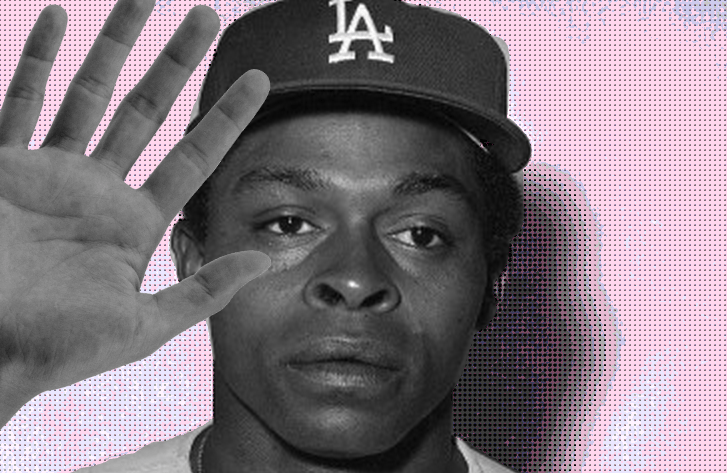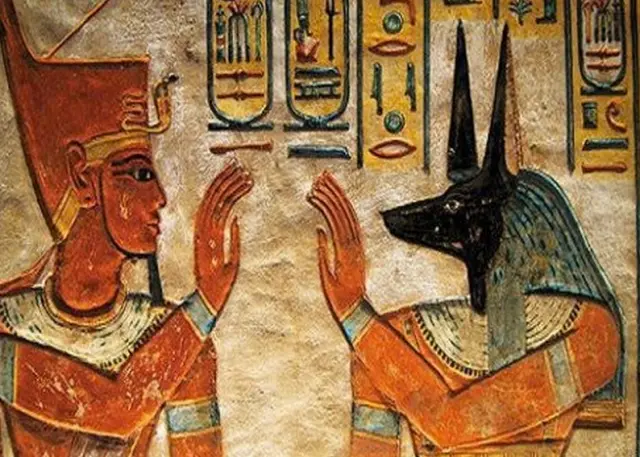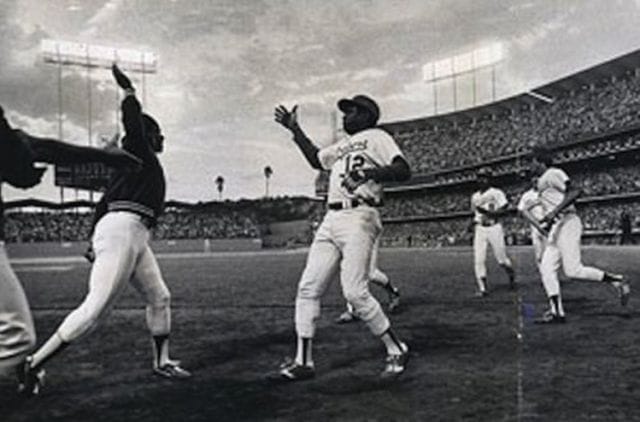
high-five (n. Slang): a gesture of greeting, elation, or victory in which one person slaps an upraised palm against that of another person.
![]()
The high five is ubiquitous. It’s a gesture that permeates every social environment — the workplace, the bar, the middle school kickball field — and it seems to be appropriate in almost any situation. Your friend got married? High five. You chugged an entire liter of IPA? High five. You just re-enacted, word-for-word, the opening sequence of A Clockwork Orange? High five! Since its inception, the hand-slapping maneuver has taken on multiple iterations and has never fallen out of style.
But tracing the origins of the high five reveals a riveting, heroic, dark story that seems to be everything the joyous gesture is not.
Origins of the High Five
The motion of slapping hands with someone else has been around for thousands of years, and is nearly impossible to trace. Ancient Egyptian hieroglyphics dating as far back as 3200 B.C. depict such gestures, though it is academically unconfirmed as to whether or not these qualified as modern-day high-fives. These ancient drawings also indicate little in the way of proof of origin; most depicted hands, like those below, linger inches apart, perennially etched in time as contact-less orbs of flesh.
Eras later, the “low five” — essentially the same as a high five, but underhand and below the waist — was penned in the 1920s, and was used in the African-American community as a symbol of unity. But the gesture, also known as “giving skin,” was exclusive and underground, and never experienced the widespread acceptance of its more upward twin.
Most scholars agree that the modern high five wasn’t popularized until about 35 years ago, in the cloudy twilight hours of October 2, 1977. It was the last game of the Major League Baseball season, and the Los Angeles Dodgers hosted the Houston Astros before a crowd of 42,501. Late in the sixth inning, Dodger Dusty Baker demolished a three-run home-run to tie the score — a significant moment that also made Los Angeles the first team in history to have four players with 30 home runs. Then, as journalist Jon Mooallem recounts, Baker’s teammate instigated something much greater:
“It was a wild, triumphant moment and a good omen as the Dodgers headed to the playoffs. Glenn Burke, waiting on deck, thrust his hand enthusiastically over his head to greet his friend at the plate. Baker, not knowing what to do, smacked it.”
“His hand was up in the air, and he was arching way back,” Baker later recalled. “So I reached up and hit his hand. It seemed like the thing to do.” The high five’s legend was sealed when Burke stepped to the plate next, hit a home run of his own, and returned to the dugout to return Baker’s high five.
When the high five subsequently exploded in popularity in the 1980s — the Dodgers even sold “High Five” T-shirts featured two hands slapping — historians, critics, and journalists all traced its origins back to this moment. Glenn Burke was championed as its inventor, and his story slowly emerged.
Glenn Burke: A Pioneer
Burke (left) going in for one of his infamous high fives
Born in Oakland, California in 1952, Burke was a heavily-recruited multi-sport athlete in high school. Following a brief college stint at the University of Reno-Nevada, he was selected by the Dodgers in the 17th round of the 1972 draft, and embarked on his professional baseball career. With 17-inch biceps and a gifted physique, Burke earned the nickname ‘King Kong,’ and was touted as the next Willie Mays.
When he debuted with Los Angeles in 1976, he established himself as the heart of the clubhouse. The charismatic slugger would leap up on benches and perform Richard Pryor stand-up; according to one account, he’d even “stuff towels under his shirt and waddle bowlegged around the dugout, imitating Dodgers manager Tommy Lasorda.” He was adored by his teammates and was a fan-favorite, despite posting sub-par stats and playing a limited number of games.
Then, at the onset of the 1977 season, Burke’s teammates learned that he was gay when one of Burke’s friends accidentally revealed the fact at a dinner party with the team. Burke watched his career unravel in a spire of prejudice, intolerance, and misdirected anger. Dodger Dusty Baker later recalled the team’s reaction in an interview:
“The guys didn’t want to believe it. He was built like King Kong. There was no femininity in his voice or his walk. But it all made sense when I thought about it. When we’d go on the road he always went to the YMCA to work out. And he’d never let us take him home. He’d say he had a friend coming later to pick him up and he’d wait at the far end of the parking lot.
Some guys began to make jokes like, ‘Don’t bend over in the shower when he’s around.’ I know a couple of guys felt uncomfortable in the shower…a few wore towels on their way back and forth in the locker room.”
Shortly after receiving word of Burke’s sexuality, Dodgers VP Al Campanis covertly offered the player $75,000 ($312,000 in 2014 dollars) to “get married” — nearly three times Burke’s yearly salary at the time (he politely declined). Despite the negativity surrounding his lifestyle, Burke performed decently, and the Dodgers went on to play in the World Series that year — but it didn’t help persuade management that Burke had to go.
On May 16, 1978, Burke was traded to the Oakland Athletics, with no explanation. Baker, angry about his friend’s severed contract, approached trainer Bill Buhler for some clarification. “They don’t want any gays on the team,” Buhler told him. “Everybody knows.”
In Oakland, Burke entered an intensely homophobic clubhouse.“Oh, by the way, this is Glenn Burke,” his manager once yelled across the locker room, “and he’s a faggot.” It was a word used routinely — and it was often spat in Burke’s face. But Burke found solace in San Francisco’s Castro district, just a short distance from Oakland’s ballpark: after the games, as his teammates hit clubs and picked up women, he’d slink into a taxi and secretly carouse in a community where other men understood him.
One evening, Burke even met with Dave Kopay, an NFL running back who’d recently revealed his homosexuality; together, they shared stories of pain and exclusion. Kopay recalls Burke’s anguish:
“He was very nervous about who and what he was. I had compensated for my gayness by going from a player who did not like contact in college to being a super-aggressive player in the pros, as a disguise. It’s common among gay athletes, overcompensating for one’s sexuality. Glenn might have been doing the same thing, but it doesn’t work in baseball. There, you have to be relaxed, not overaggressive. I couldn’t really advise him, except to tell him to follow his instincts. There is really no one to talk to in sports when you are gay. Who can you really trust? There are so many insecurities, it’s tragic.”
These pressures got the best of Burke; midway through spring training in 1980, at the age of 27, he walked away from professional baseball.
![]()
In the following years, he moved to the Castro, joined the Gay Softball League, and became a cult icon in San Francisco’s gay community. He could often be seen high-fiving other gay residents, and the gesture subsequently became a symbol of gay pride — a friendly beacon of identification. When he came out publicly in a 1982 article, he became the first openly-gay professional baseball player in history, and called the Castro his “heaven” — an endless party where he was the hero, not the oppressed gay man.
But things took a sad turn for Burke. In 1987, he was crossing the street, when a speeding car hit him, shattering his right leg in four places. The injury left him unable to play, and he spiraled into a depression only sated by cocaine use. When his money ran out, he turned to grand theft — an offense that landed him in San Quentin prison, and reaped him of all credibility as a role-model. He was released penniless, addicted to crack, and homeless; he scuffled down the same streets where he once was a legend — this time panhandling, and mooching off friends.
Then, Burke’s worst tragedy struck: he contracted AIDS, one of some 20,000 cases in San Francisco at the time; within a few years, he was on his deathbed. A 1994 piece in The Milwaukee Sentinel presents Burke curled quietly in a ball, his swollen feet laced with purple sarcoma lesions. In the article, he reveals he’d known he was gay since he was 23, when he “had a fling” with his old high school drama teacher — a man twice his age. He also speaks of “at least six other gay ballplayers” — none of whom had his courage to come out to teammates. But the dying Burke wasn’t a bitter man. “I had a nice life,” he told the reporter. “Being black and gay made me tougher. You had to be tough to make it. Yeah, I’m proud of what I did.”
Lasting Legacies

Burke’s grave in Mountain View Cemetery (Oakland, CA)
In the dark hours of May 30, 1995, Glenn Burke passed away. The man who invented the high five, noted one obituary, could now “barely lift his arm.” Most papers chose to entirely gloss over Burke’s courageousness in facing homophobia in professional sports, and instead focused solely on his popularization of the then-famous hand slap.
Even this claim was challenged. In 2002, Lamont Sleets, a past college basketball star, announced he’d originated the high five in the 1960s; the story proved to be an elaborate publicity hoax concocted by the founders of National High Five Day, but still convoluted Burke’s legend and raised new concerns about his credibility.
For Burke though, the high five was never about receiving recognition; it was just a small expression of his persona. Like Burke, the gesture was — and still is — jovial, spirited, and playful, but also physical and tough. It’s a duality he carried with him to his last interview: with one slap, he’d simultaneously tell you that he loved you, but that he “could still kick your ass.” But moreover, as one of Burke’s close friends later said, “the high five liberated everybody” — not just the man who invented it — by “uncorking our repressed longing for personal expression.”
This post was written by Zachary Crockett. Follow him on Twitter here, or Google Plus here.






